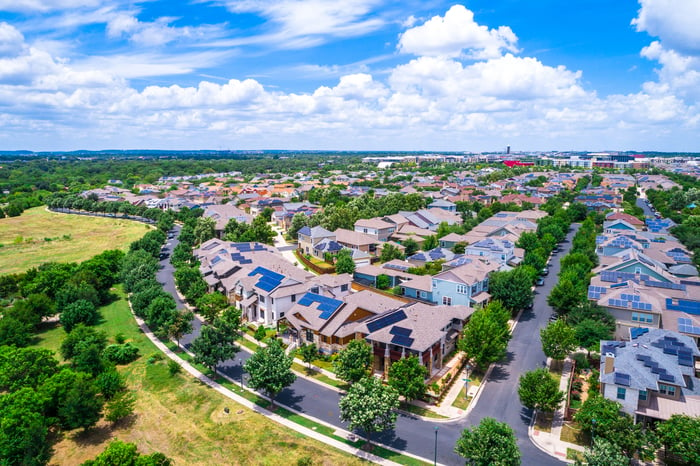SolarEdge Technologies' (SEDG 4.15%) stock price slumped after it reported its third-quarter results last week. Not only did the company's revenue fall by 18% year over year, but management also provided a weak outlook for the fourth quarter. The big question is: Do these results reflect a deterioration in the company's longer-term prospects, or was the sell-off due to some profit booking in a stock that is still up by 144% year-to-date?
COVID-19 hits revenues
SolarEdge's Q3 revenue decline contrasted sharply with its historic pattern -- the manufacturer of power inverters and optimizers has delivered average growth of 45% a year since its listing in 2015. Last quarter, however, sales were impacted by a slower-than-expected recovery in commercial installations. Installations of new solar power systems, particularly in the commercial segment, remained stalled due to the COVID-19 pandemic.
Management anticipates that commercial installations will recover significantly in 2021, and that its sales will be enhanced by its new series of optimizers, which are more cost effective.

Image source: Getty Images.
In comparison, residential product sales were relatively resilient in Q3. Revenue in that segment grew by 2% sequentially, in line with management's guidance.
SolarEdge expects its commercial sales will remain weak in Q4. Overall, the company expects a 15% year-over-year decline in sales in the period, though that would also amount to 5% growth sequentially. Gross margins are expected to be within the 32% to 34% range, in line with where they landed in Q3.
It is worth noting that SolarEdge's revenue slump did not reflect a loss of market share -- indeed, on the Q3 earnings conference call, CEO Zvi Lando asserted that on the market share front, the company was largely doing better now than a year ago. Management is confident that SolarEdge will maintain or improve its share in 2021.
Growth avenues
In addition to inverters and optimizers, a key long-term growth driver for SolarEdge could be energy storage products. The company announced a delay of a few months in the release of its residential battery. The batteries are now expected to start contributing to the company's revenues in the second quarter of 2021. This news could have been one of the factors that contributed to the stock's fall after the company reported results.
The postponement of the battery's launch was due to pandemic-related travel restrictions. However, revenues from the product in 2020 were expected to be minimal, and a few months' delay shouldn't be a major concern.
Another key growth avenue for SolarEdge in the long term could be in the electric vehicles market. Its powertrain units for light goods vehicles, light commercial vehicles, and e-motorcycles are currently in the testing and qualification stage.
Growing competition
SolarEdge looks well-positioned to grow considering the positive outlook for solar energy as well as the company's leading position in the photovoltaic inverters and optimizers segment. However, it faces increased competition from other suppliers, which may strain the company's margins.
At the same time, changes in government policies and subsidies may significantly impact the demand for SolarEdge's products. It will need to consistently deliver innovative offerings at competitive prices to maintain and grow its market share.
A great growth stock?
Considering the risks that SolarEdge faces, investors can't assume that it will get back to achieving the high levels of revenue and earnings growth that it did prior to 2020. That's why, with a price-earnings ratio of around 69, the stock looks a bit expensive, even after its recent drop.
Even so, SolarEdge offers promising growth prospects. Its third-quarter performance doesn't reflect a significant change in its long-term trajectory. Further, even without a Democratic majority in the Senate, President-elect Joe Biden's arrival in the Oval Office should be bullish for solar stocks. SolarEdge's share price drop offers an entry point for long-term investors. And, given the company's weak outlook for the fourth quarter, the stock may remain volatile in the near term, which could provide additional attractive entry points. Buying on the dips could be a great way to build a position in this stock.





